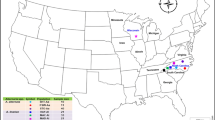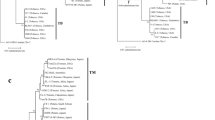Abstract
A two-year survey was conducted to investigate the level of genetic variability occurring across growing seasons within natural populations of Alternaria solani, the cause of early blight in potato. Genetic diversity among 151 isolates, taken from a disease resistance breeding trial, was assessed using seven random amplified polymorphic DNA (RAPD) primers and sequence analyses of portions of the internal transcriber spacer (ITS) region and Alt a1 gene. A. solani isolates were grouped into 19 RAPD profiles to examine the distribution patterns of genetically distinct isolates within and between years. Seven RAPD profiles were found spanning both years with profiles 6 and 13 being the most prevalent. Five unique profiles were found only in 2008 and seven were found only in 2009. No variation was observed among isolates of A. solani based on ITS and Alt a1 sequence analyses, but a distinction between A. solani and A. dauci, a close relative outgroup was identified. Pathogenicity was also assessed using a tissue culture plantlet assay on four isolates and two reference cultures. Differences in virulence were observed among the isolates examined.




Similar content being viewed by others
References
Agrios, G. N. (2005). Plant pathology. London: Elsevier.
Budak, H., Shearman, R. C., Parmaksiz, I., & Dweikat, I. (2004). Comparative analysis of seeded and vegetative biotype buffalograsses based on phylogenetic relationship using ISSRs, SSRs, RAPDs, and SRAPs. Theoretical and Applied Genetics, 109, 280–288.
Chaerani, R., & Voorrips, R. E. (2006). Tomato early blight (Alternaria solani): the pathogen, genetics, and breeding for resistance. Journal of General Plant Pathology, 72, 335–347.
Christ, B. J., & Haynes, K. G. (2001). Inheritance of resistance to early blight disease in a diploid potato population. Plant Breeding, 120, 169–172.
Craven, K. D., Velez, H., Cho, Y., Lawrence, C. B., & Mitchell, T. K. (2008). Anastomosis is required for virulence of the fungal necrotroph Alternaria brassicicola. Eukaryotic Cell, 7, 675–683.
Dalgaard, P. (2008). Introductory statistics with R. Springer.
Dita Rodriguez, M. A., Brommonschenkel, S. H., Matsuoka, K., & Mizubuti, E. S. G. (2006). Components of resistance to early blight in four potato cultivars: effect of leaf position. Journal of Phytopathology, 154, 230–235.
Haga, E. (2011). Characterization of early blight resistance derived from the wild potato species solanum berthaultii. Madison: M.S. University of Wisconsin-Madison.
Holm, A. L., Rivera, V. V., Secor, G. A., & Gudmestad, N. C. (2003). Temporal sensitivity of Alternaria solani to foliar fungicides. American Journal of Potato Research, 80, 33–40.
Hong, S. G., Cramer, R. A., Lawrence, C. B., & Pryor, B. M. (2005). Alt a 1 allergen homologs from Alternaria and related taxa: analysis of phylogenetic content and secondary structure. Fungal Genetics and Biology, 42, 119–129.
Hooker, W. J. (1981). Compendium of potato diseases. St. Paul: APS Press.
Jansky, S. H., Rouse, D. I., & Kauth, P. J. (2004). Inheritance of resistance to Verticillium dahliae in diploid interspecific potato hybrids. Plant Disease, 88, 1075–1078.
Kadam, B., Chavhan, R., Chakrabarty, P., & Patil, F. (2009). Characterization of variability in some pathogenic species of Alternaria based on the nucleotide sequence of ribosomal DNA. Journal of Plant Biochemistry and Biotechnology, 18, 59–64.
Kosman, E., & Leonard, K. J. (2005). Similarity coefficients for molecular markers in studies of genetic relationships between individuals for haploid, diploid, and polyploid species. Molecular Ecology, 14, 415–424.
Kumar, V., Haldar, S., Pandey, K., Singh, R., Singh, A., & Singh, P. (2008). Cultural, morphological, pathogenic and molecular variability amongst tomato isolates of Alternaria solani in India. World Journal of Microbiology and Biotechnology, 24, 1003–1009.
Morris, P. F., Connolly, M. S., & St Clair, D. A. (2000). Genetic diversity of Alternaria alternata isolated from tomato in California assessed using RAPDs. Mycological Research, 104, 286–292.
Peever, T. L., Canihos, Y., Olsen, L., Ibañez, A., Liu, Y.-C., & Timmer, L. W. (1999). Population genetic structure and host specificity of Alternaria spp. causing brown spot of minneola tangelo and rough lemon in Florida. Phytopathology, 89, 851–860.
Peever, T. L., Ibañez, A., Akimitsu, K., & Timmer, L. W. (2002). Worldwide phylogeography of the citrus brown spot pathogen, Alternaria alternata. Phytopathology, 92, 794–802.
Petrunak, D. M., & Christ, B. J. (1992). Isozyme variability in Alternaria solani and A. alternata. Phytopathology, 82, 1343–1347.
Roberts, R. G., Reymond, S. T., & Andersen, B. (2000). RAPD fragment pattern analysis and morphological segregation of small-spored Alternaria species and species groups. Mycological Research, 104, 151–160.
Rogers, P. M. (2007). Diversity and biology among isolates of Alternaria dauci collected from commercial carrot fields. Madison: Ph.D. University of Wisconsin-Madison.
Rosenzweig, N., Atallah, Z. K., Olaya, G., & Stevenson, W. R. (2008). Evaluation of QoI fungicide application strategies for managing fungicide resistance and potato early blight epidemics in Wisconsin. Plant Disease, 92, 561–568.
Rotem, J. (1966). Variability in Alternaria porri f. solani. Israel Journal of Botany, 15, 48–57.
Saikia, R., Singh, B. P., Kumar, R., Singh, T., & Arora, D. K. (2006). Use of molecular tools to study the diversity of phytopathogenic fungi. Indian Journal of Microbiology, 46, 293–306.
Scheffer, R. P. (1992). Ecological and evolutionary roles of toxins from Alternaria species pathogenic to plants. In J. Chelkowski & A. Visconti (Eds.), Alternaria: biology, plant diseases and metabolites. Amsterdam: Elsevier.
Shahbazi, H., Aminian, H., Sahebani, N., & Halterman, D. (2010). Biochemical evaluation of resistance responses of potato to different isolates of Alternaria solani. Phytopathology, 100, 454–459.
van der Waals, J. E., Korsten, L., & Aveling, T. A. S. (2001). A review of early blight of potatoes. African Plant Protection, 7, 91–102.
van der Waals, J., Korsten, L., Aveling, T., & Denner, F. (2003). Influence of environmental factors on field concentrations of Alternaria solani conidia above a South African potato crop. Phytoparasitica, 31, 353–364.
van der Waals, J. E., Korsten, L., & Slippers, B. (2004). Genetic diversity among Alternaria solani isolates from potatoes in South Africa. Plant Disease, 88, 959–964.
Wangeline, A. L. (2001). Involvement of Alternaria fungi in early blight of potatoes in the high plains. Ph.D. University of Wyoming.
Weir, T. L., Huff, D. R., Christ, B. J., & Romaine, C. P. (1998). RAPD-PCR analysis of genetic variation among isolates of Alternaria solani and Alternaria alternata from potato and tomato. Mycologia, 90, 813–821.
Williams, J. G. K., Kubelik, A. R., Livak, K. J., Rafalski, J. A., & Tingey, S. V. (1990). DNA polymorphisms amplified by arbitrary primers are useful as genetic markers. Nucleic Acids Research, 18, 6531–6535.
Zietkiewicz, E., Rafalski, A., & Labuda, D. (1994). Genome fingerprinting by simple sequence repeat (SSR)-anchored polymerase chain reaction amplification. Genomics, 20, 176–183.
Acknowledgments
Solanum raphanifolium and S. berthaultii germplasm was supplied by the NRSP-6 Potato Genebank. The statistical advice of Cecile Ane and Nicholas Keuler (UW-Madison) is gratefully acknowledged. Additionally, Emily Haga is recognized for permitting extraction of Alternaria solani isolates from her EB resistant breeding material.
Author information
Authors and Affiliations
Corresponding author
Electronic supplementary material
Below is the link to the electronic supplementary material.
Supplemental Table 1
Alternaria solani isolates extracted from early blight lesions on plants with various family backgrounds during the 2008 field season. Families were created using wild species S. raphanifolium (rap), S. berthaultii (ber), cultivated diploid S. tuberosum and F1 hybrids. All female and male parents are clones. Up to three isolates were collected from each plant to determine isolate genetic variability on individual plants. Assigned genotype groups based on RAPD primer analyses are included. (DOCX 53.2 kb)
Supplemental Table 2
Alternaria solani isolates extracted from early blight lesions on plants with various family backgrounds during the 2009 field season. Families were created using wild species S. raphanifolium (rap), S. berthaultii (ber), cultivated diploid S. tuberosum and F1 hybrids. All female and male parents are clones. Up to three isolates were collected from each plant to determine isolate genetic variability on individual plants. Assigned genotype groups based on RAPD primer analyses are included. (DOCX 54.6 kb)
Supplemental Table 3
Seven RAPD primers 203, 284, 285, B4, B5, B8 and B12 chosen based on their capacity to reveal reproducible polymorphisms among nineteen RAPD profiles. Primers 284, 285, and B5 were each found to only produce a single polymorphism whereas two polymorphisms were scored for primers B5 and B8. Presence of polymorphic bands is indicated by estimated base pair size (bp). Size estimates were determined using a 1KB ladder. If no base pair size is provided, bands were not present. (DOCX 18 kb)
Rights and permissions
About this article
Cite this article
Weber, B., Halterman, D.A. Analysis of genetic and pathogenic variation of Alternaria solani from a potato production region. Eur J Plant Pathol 134, 847–858 (2012). https://doi.org/10.1007/s10658-012-0060-z
Accepted:
Published:
Issue Date:
DOI: https://doi.org/10.1007/s10658-012-0060-z




